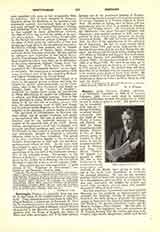

Bentley, JOHN FRANCIS, English architect, b. at Doncaster, Yorkshire, in 1839; d. in London, February, 1902. From early days he exhibited a strong inclination towards the profession in which he was to make so great a mark. His parents were not in sympathy with him, so, at the age of sixteen, he placed himself voluntarily with the Clerk of the Works at Lover-sail Church. In 1855 he began his probation with Sharpe, Stewart & Co., of Manchester, going to London, in 1858, where he was associated with Holland & Hannan and then with Henry Clutton. He started f or himself in 1868. He was a firm believer in the architectural principles and methods of the Middle Ages, giving to every detail in his work, from foundation to furniture, his personal attention. He was an apt modeler and had tried his hand with success at stone carving. As a draughtsman, and especially as a colorist, he was very successful, his designs for marble and metal work, jewelry, stained glass, and heraldic decorations being of great beauty.
His first important commission was from Cardinal Manning, for the seminary at Hammersmith, and amongst his buildings should be mentioned the Church of the Holy Rood, at Watford; the convent chapel, at Braintree; the chapel of Beaumont College, Old Windsor; St. Anne’s Cathedral, Leeds; and St. Mary’s, Caftan Flue, Chelsea. He was also responsible for the baptistery, font, and monstrance at St. Francis, Notting Hill; the reredos and altar at St. Charles, Ogle Street, Marylebone, sedilia and Sacred Heart chapel in the church of the Jesuit Fathers at Farm Street; and the decoration at Carlton Towers. In 1894, he received his commission to build the cathedral at Westminster, and at once started for Italy to make a careful study of the various great basilicas, and the mosaic work at Ravenna. He devoted himself with great concentration to this, his life memorial, producing the most remarkable ecclesiastical building erected in England since the Reformation, and receiving high praise all over Europe on his extraordinary success.
He was a person of brusque, reserved manner, but kind and friendly to those who really knew him. He had the strongest dislike to the preparation of show drawings and to the system of architectural competition and, being a man wholly lacking in self-assertion, and reticent in conversation, was never as well known in general circles as he deserved to be. His great characteristics as an architect were his careful attention to detail, his solicitude that all the fittings should be in perfect harmony with the building, and the sparing use he made of iron. He was awarded the gold medal of the Institute of Architects in February, 1902, but never received it, as on the 1st of March he was seized with paralysis and died the following morning. He was present at the trial of acoustic qualities made in his cathedral, but was not spared to see its formal opening. He was buried at Mortlake.
GEORGE CHARLES WILLIAMSON

